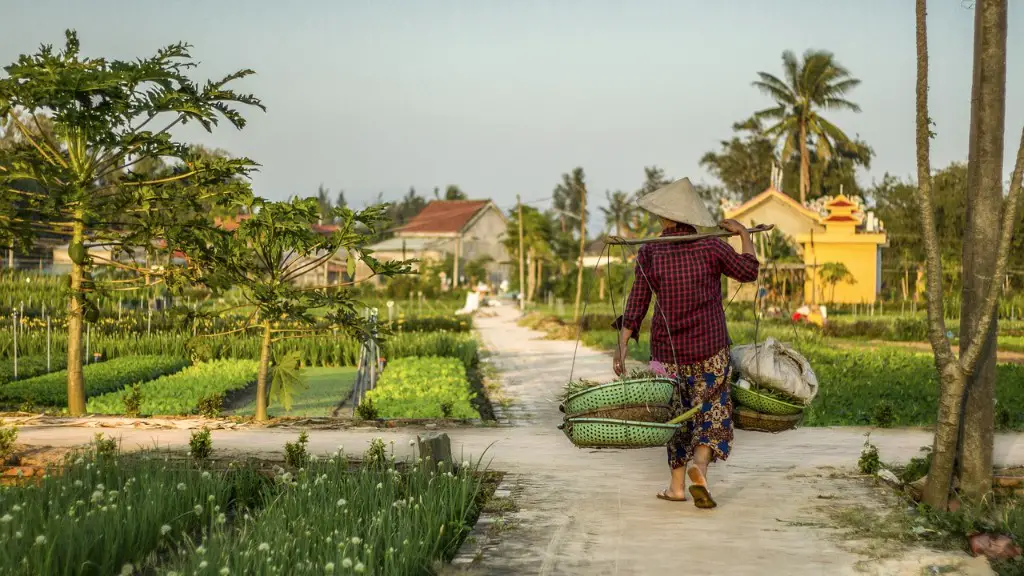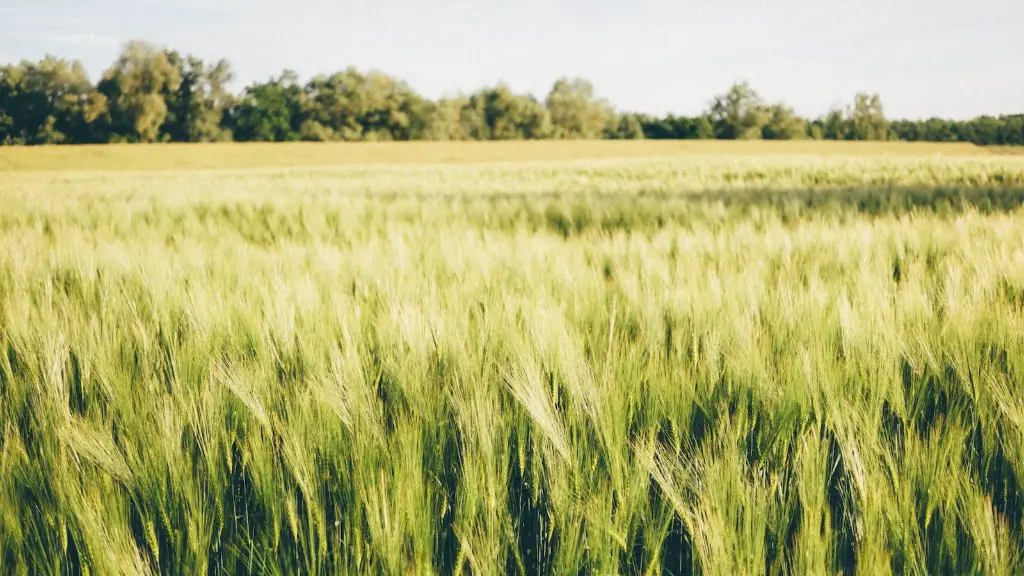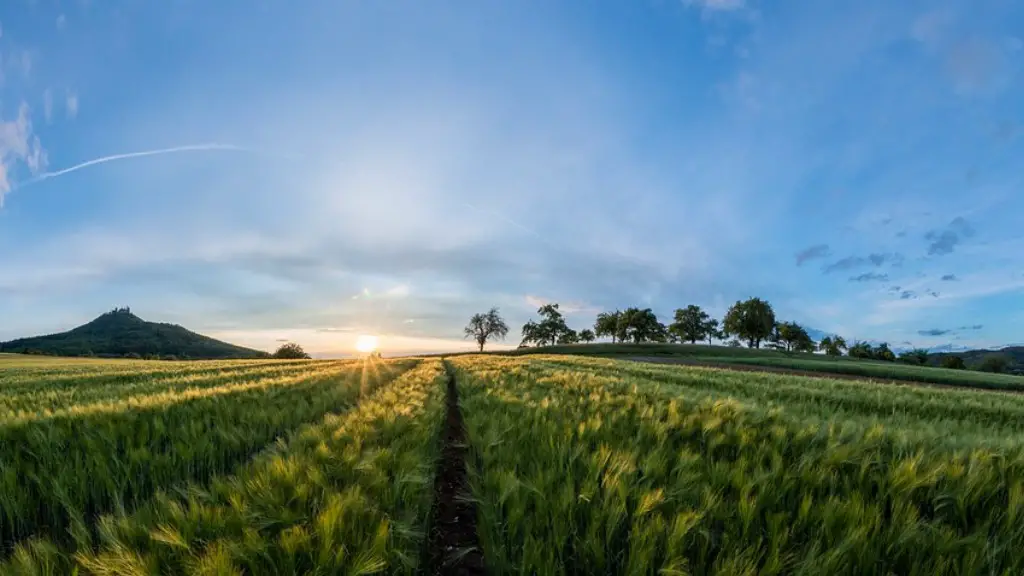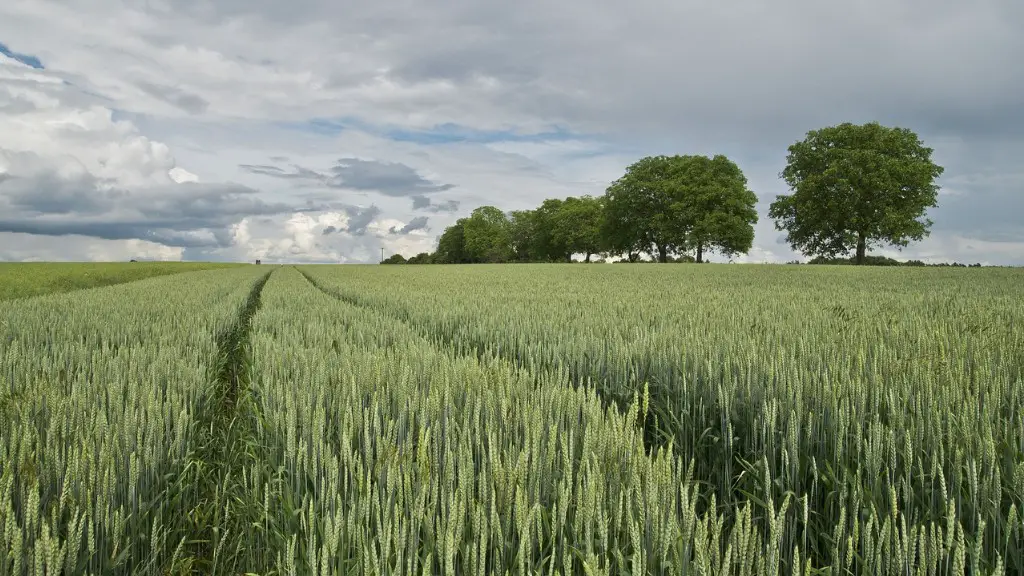Agriculture is the process of producing food, feed, fiber and other desired products by the cultivation of certain plants and the raising of domesticated animals. Agriculture was the key development in the rise of sedentary human civilization, whereby farming of domesticated species created food surpluses that allowed people to live in cities. The history of agriculture began thousands of years ago. After gathering wild grains beginning at least 105,000 years ago, nascent civilizations began to develop agriculture about 11,500 years ago. The study of agriculture is known as agricultural science. The development of agriculture allowed the human population to grow many times larger than could be sustained by hunting and gathering, and allowed for the rise of civilizations. Agriculture has since played a key role in human history. It has been the basis for civilizations, has provided employment for millions of people, and has been a major driver of technological advancement.
The different types of agriculture are: subsistence, commercial, and industrial.
Subsistence agriculture is the type of agriculture that is done primarily to provide for the needs of the farmer and their family. This type of agriculture is typically done on a small scale, with the farmer using simple tools and methods.
Commercial agriculture is the type of agriculture that is done primarily to generate income. Farmers who engage in commercial agriculture typically grow crops or raise animals that can be sold in the market. This type of agriculture is typically done on a larger scale, with the farmer using more sophisticated tools and methods.
Industrial agriculture is the type of agriculture that is done primarily to produce a large quantity of food or other products. This type of agriculture is typically done on a large scale, with the farmer using highly mechanized and specialized equipment.
What are the 7 sectors of agriculture?
The agricultural sector is a vital part of the economy, providing food and other products for people and animals. The sector is also a major employer, with millions of people working in agriculture-related jobs. The agricultural sector includes a wide range of activities, from farming and livestock raising to food processing and retailing.
Shifting cultivation is a type of agriculture where crops are grown for a short period of time and then the land is allowed to rest for a period of time before the cycle is repeated. This type of agriculture is often used in areas where the soil is not very fertile.
Subsistence farming is a type of agriculture where farmers grow enough food to feed themselves and their families. They do not usually have any surplus to sell.
Pastoralism is a type of agriculture that relies heavily on grazing animals such as cows, sheep, and goats. This type of agriculture is often used in areas where there is not enough rainfall to grow crops.
Intensive farming is a type of agriculture where farmers use large amounts of land, labor, and capital to produce large quantities of food. This type of agriculture is often used in areas where the climate is good and the soil is fertile.
What are the 4 areas of agriculture
The four main branches of agriculture are livestock production, crop production, agricultural economics, and agricultural engineering. Each of these branches has its own unique set of skills and knowledge that are essential for the successful management of an agricultural operation.
Industrialized agriculture is a type of agriculture that is characterized by the use of large-scale production methods, as well as advanced technology and machinery. This type of agriculture is typically used in order to produce large quantities of food, as well as other crops, for commercial purposes.
Subsistence agriculture, on the other hand, is a type of agriculture that is typically used in order to produce enough food to meet the needs of a small community or family. This type of agriculture is typically less intensive than industrialized agriculture, and often relies on manual labor and traditional methods.
What are the 12 types of agriculture?
There are many different types of farms, each with its own unique characteristics. Here are 15 different types of farms:
1. Aquaculture Farming: Aquaculture is the cultivation of aquatic animals or plants, usually in ponds or tanks.
2. Cooperative Farming: Cooperative farming is a type of agriculture in which farmers work together to pool resources and share costs.
3. Hay Farming: Hay farming is the practice of growing and harvesting hay for use as livestock feed.
4. Organic Farming: Organic farming is a type of agriculture that focuses on producing food without the use of synthetic pesticides or fertilizers.
5. Urban Farming: Urban farming is the practice of growing food in urban areas, often on rooftops or in vacant lots.
6. Nomadic Farming: Nomadic farming is a type of agriculture in which farmers move their livestock from place to place in search of pasture.
7. Sedentary Farming: Sedentary farming is a type of agriculture in which farmers stay in one place and grow crops or raise livestock.
8. Intensive Farming: Intensive farming is a type of agriculture that uses high levels of inputs such as irrigation, fertilizer, and pesticides in order to produce large yields.
There are many different branches of agriculture, each with its own focus and area of expertise. Agronomy, for example, is the study of soil and crop management, while horticulture focuses on the cultivation of plants. Plant breeding and genetics is concerned with developing new varieties of plants, and seed science deals with the production and storage of seeds. Crop physiology deals with the way plants grow and respond to their environment, while plant pathology is concerned with the study of plant diseases. Plant protection deals with the control of pests and other threats to plants, and soil science is concerned with the study of soil and its properties.
What is the most basic form of agriculture?
Subsistence farming is a form of farming in which nearly all of the crops or livestock raised are used to maintain the farmer and the farmer’s family, leaving little, if any, surplus for sale or trade. Preindustrial agricultural peoples throughout the world have traditionally practiced subsistence farming.
Subsistence farming generally involves a simple division of labor between men and women. Men are typically responsible for tasks such as plowing, sowing, and harvesting, while women are responsible for tasks such as weeding, gathering firewood, and preparing meals. In many subsistence societies, children also play an important role in agricultural production, helping with tasks such as herding livestock and gathering fruits and vegetables.
Subsistence farming is often carried out using simple tools and techniques, and crops are often grown using organic methods. This type of farming is typically less labor-intensive and more sustainable than intensive commercial farming, which relies on heavy use of chemical fertilizers, pesticides, and other inputs.
Despite its simplicity, subsistence farming is often very labor-intensive and time-consuming. Farmers typically work long hours, and yields are often low. As a result, subsistence farmers often live in poverty, with little opportunity to improve their standard of living.
Agricultural activities play an important role in the lives of many people in different communities around the world. Some of the most common forms of agricultural activities include cultivation and growing of crops, rearing of livestock, fish farming, and horticulture. In addition, many people in rural communities also engage in activities such as beekeeping and snail farming. Each of these agricultural activities provides people with different benefits, which help to improve their livelihoods and provide them with food and other essential items.
What are the three major types of agriculture
Three Main Farming Systems
Irrigated: This is the process of providing water to crops through a system of pumps and pipes. This type of farming is typically found in areas where rainfall is insufficient or unreliable.
Semi-mechanized: This system relies on mechanized equipment for some aspects of crop production, such as ploughing and harvesting, but manual labour is still used for tasks such as weeding and planting. This type of farming is common in developing countries.
Traditional: This is the most basic form of farming, and involves using simple tools and methods that have been passed down through generations. This type of farming is still practised in many parts of the world.
Agriculture is the science and art of cultivating plants and animals for food, fiber, and other products used to sustain and enhance human life. The five major branches of agriculture are agronomy, horticulture, agricultural engineering, animal science, and agricultural economics.
What are the 8 branches of the agricultural industry?
Agriculture is the cultivation of land and breeding of animals and plants to provide food, fiber, medicinal plants and other products to sustain and enhance human life. Agriculture was the key development in the rise of sedentary human civilization, whereby farming of domesticated species created food surpluses that supported the development of civilizations. The study of agriculture is known as agricultural science. The history of agriculture dates back thousands of years, and its development has been driven and defined by greatly different climates, cultures, and technologies. Agricultural produce can be grouped into foods, fibers, fuels and raw materials. Specific foods include cereals, vegetables, fruits, oils, meats and wool. fibers include cotton, flax and hemp; fuels include firewood, biofuel and natural gas; and raw materials include lumber and bamboo. Over time, agriculture has been characterized as a series of “revolutions” and technological frontier changes. Major agricultural revolutions include the Neolithic Revolution, when agriculture was first adopted, and the Green Revolution, when improved agronomy and breeding created vastly higher yields.
Soil science, crop science, horticulture, agricultural economics, agricultural engineering, agricultural extension, animal science, and fisheries are all sub-branches of agriculture.Each of these sub-branches have their own specific focus within the agricultural field.Soil science deals with the physical, chemical, and biological properties of soils.Crop science focuses on the production, protection, and utilization of crops.Horticulture deals with the cultivation of fruits, vegetables, flowers, and ornamental plants.Agricultural economics deals with the economic aspects of agriculture, including farm management, marketing, and policy.Agricultural engineering focuses on the design and management of systems for crop production and animal husbandry.Agricultural extension deals with the transfer of research findings and technology to farmers and other practitioners.Animal science focuses on the production, care, and management of livestock.Fisheries focus on the production and management of fish and other aquatic animals.
What is the difference between agriculture and farming
Agriculture is a vital sector of the economy, responsible for the production of food, fibre and fuel. The sector is also a major contributor to the country’s export earnings. Agriculture employs a significant proportion of the Australian workforce, with around 1.6 million people employed in the sector.
The Australian agricultural sector is highly diversified, with a range of different production systems and products. The sector is exposed to a range of risks, including climatic variability, drought, pests and diseases. In recent years, the sector has also been affected by the increasing globalisation of markets and increased competition from overseas producers.
There are many types of agriculture, but the most common are: dry farming, wet farming, subsistence farming, shifting agriculture, intensive agriculture, and commercial agriculture.
What are the 20 types of agriculture?
There are many different types of agriculture, each with its own advantages and disadvantages. nomadic Herding is great for moving livestock to new pastures, but can be difficult to manage. Livestock Ranching requires a lot of land, but can be very profitable. Shifting Cultivation is a sustainable way of farming, but can be very labor-intensive. Intensive Subsistence Farming is very efficient, but can be difficult to scale up. Commercial Plantations require a lot of investment, but can be very productive. Mediterranean Agriculture is very climate-sensitive, but can be very profitable. Commercial Grain Farming is very capital-intensive, but can be very productive.
Modern agriculture is a type of farming that uses techniques and technologies to increase yields, improve quality, and reduce labor costs. Common practices include crop rotation, soil VI(innoculation), conservation tillage, and the use of chemical fertilizers, pesticides, and herbicides.
The goal of modern agriculture is to produce more food with fewer inputs while having minimal impact on the environment. This type of agriculture is sometimes called “intensive” or “high-tech” farming.
Organic agriculture is a type of modern agriculture that uses natural processes and products instead of synthetic ones. This includes using natural fertilizers and pest controls, and often results in higher yields and improved quality.
Sustainable agriculture is a type of modern agriculture that aims to produce food while minimizing negative environmental impacts. This includes using techniques that conserve water and soil, and using renewable resources.
What are the 9 types of farming
Farming refers to the cultivation of crops and raising of livestock for economic purposes. Farming can be done on a small scale, such as in a backyard, or on a large scale, such as in a field. There are many different types of farming, each with its own benefits and drawbacks.
Dairy farming is the raising of cows for milk production. Dairy farms are typically large operations that require a significant amount of land and resources. Some dairy farms also produce cheese and other dairy products.
Commercial farming is the production of crops or livestock for sale. Commercial farms are typically large operations that use modern techniques and technology.
Plantation farming is the cultivation of crops, such as coffee, cocoa, and sugar cane, on large estates. Plantation farms typically employ a large number of workers, often from other countries.
Commercial grain farming is the production of wheat, corn, and other grains for sale. Commercial grain farms are typically large operations that use modern techniques and technology.
Commercial mixed farming is the production of both crops and livestock for sale. Commercial mixed farms are typically large operations that use modern techniques and technology.
Primitive subsistence farming is the production of food for the farmer and his family. Primitive subsistence farms
Agricultural practices are important for maintaining the quality of the soil and ensuring optimal growth of crops. The main steps for agricultural practices include preparation of soil, sowing, adding manure and fertilizers, irrigation, harvesting and storage.
Soil preparation is vital for agriculture as it allows for better aeration and drainage of the roots, and also prevents soil compaction. The process of soil preparation includes ploughing, harrowing, and levelling.
Sowing is the next step after preparing the soil, and it involves planting the seeds at the correct depth and spacing. It is important to ensure that the seeds are of good quality and that they are well-seeded to ensure germination.
After sowing, manure and fertilizers are added to the soil to provide nutrients for the crops. The type of manure and fertilizer used will vary depending on the type of crop being grown.
Irrigation is necessary to provide water for the crops, and it can be done through sprinklers, drip irrigation, or flooding. The amount of water used will depend on the type of crop, the weather, and the soil conditions.
Harvesting is the process of collecting the crops from the field, and it is usually done by
Warp Up
Farming systems are diverse and depend on a number of factors, including climate, soil type, morphology, area under cultivation, and availability of water. Agriculture can be broadly classified into two main types: subsistence and commercial. subsistence agriculture is carried out to produce enough food for the farmer and their family, with any surplus being sold or bartered. Commercial agriculture, on the other hand, is carried out to generate profit. It involves large-scale production of crops and livestock for sale in the market.
There are three main types of agriculture: subsistence, commercial, and mixed. Subsistence agriculture is when farmers grow enough food to feed themselves and their families. Commercial agriculture is when farmers grow crops or raise animals to sell for profit. Mixed agriculture is a combination of subsistence and commercial agriculture.





